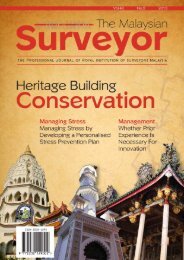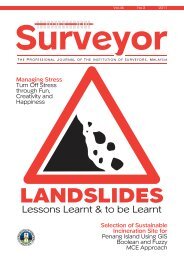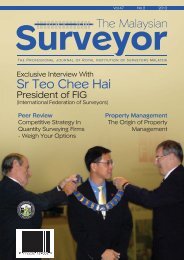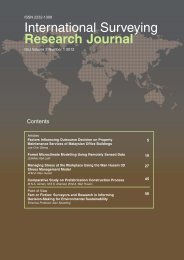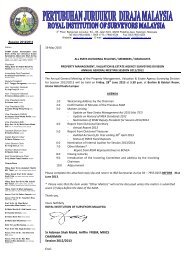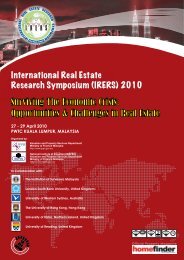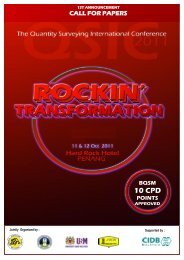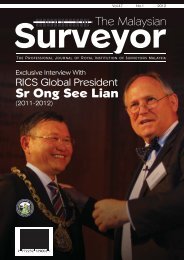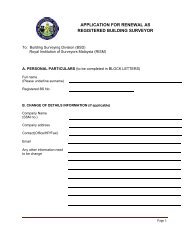Full 46.1 - Royal Institution of Surveyors Malaysia
Full 46.1 - Royal Institution of Surveyors Malaysia
Full 46.1 - Royal Institution of Surveyors Malaysia
You also want an ePaper? Increase the reach of your titles
YUMPU automatically turns print PDFs into web optimized ePapers that Google loves.
THE MALAYSIAN SURVEYOR | Vol.46 | No.1 | 2011<br />
considered beforehand, sustainability and adaptive<br />
reuse <strong>of</strong> the mansion would have been effective, as<br />
proposed by most researchers in their theoretical<br />
literature. This indicated a misguided decision which<br />
resulted in complications upon the building’s new<br />
adopted use. The initial idea seemed workable, but<br />
due to unforeseen state <strong>of</strong> affairs, the building failed<br />
to serve its intended purpose. This displayed an<br />
economic issue as efforts to generate business were<br />
misguided and unwise.<br />
4.3 Organisational issues<br />
Ill thought out and inappropriate modifications can<br />
be witnessed in the introduction <strong>of</strong> a vignette <strong>of</strong> a<br />
wharf scene and a construction <strong>of</strong> a “Barkath” Sundry<br />
store on the first floor <strong>of</strong> the Syed Alatas Mansion<br />
where the original open terracotta-tiled balcony area<br />
and timber landing remained. This is the result <strong>of</strong><br />
poor decision-making and planning within the<br />
responsible organisation. Although the intention <strong>of</strong><br />
Pic 5: Another view <strong>of</strong> the Syed Alatas Mansion<br />
these ideas had hoped to enliven the mansion with<br />
more activity, these constructions rather contributed<br />
to the destruction <strong>of</strong> the mansion as much historic<br />
fabric was lost in the process.<br />
Furthermore, as the building was used as an<br />
exhibition, a plastic ro<strong>of</strong> was also installed to protect<br />
the exhibits in some areas, and the 100 year old<br />
terracotta tiles were painted blue to represent the<br />
sea. Apparently, this caused the area to become<br />
overly hot which damaged the building fabric from<br />
sweat and paint. Additionally, much <strong>of</strong> the vignette<br />
exhibits were destroyed by rats and were found in a<br />
foul, neglected condition. In March 2007, airconditioning<br />
was installed to the mansion — the pipe<br />
work connecting the internal blowers to the exterior<br />
condensers was affixed outside <strong>of</strong> the building to<br />
minimise disturbance to the exhibits during its<br />
installation. However, this destroyed the lines <strong>of</strong> the<br />
original walls although initiatives were taken to<br />
minimise the effect. Clearly, this is against the first<br />
principle <strong>of</strong> conservation which is minimum<br />
intervention (Said, 2010).<br />
From a perspective, it can be concluded that by<br />
introducing a sundry store and installing airconditioning<br />
to the mansion, the conservation project<br />
was considerably unsuccessful in strict technical<br />
terms because the building had failed to uphold its<br />
original historic nature as outlined in the Heritage<br />
Building Act. This clearly indicates the organisation’s<br />
failure to work out right decisions in setting priorities<br />
and the more efficient types <strong>of</strong> interventions. Owing<br />
to that, the problem addresses an organisational<br />
issue — poor decision-making. In the case <strong>of</strong> the Syed<br />
Alatas Mansion, although finance was not a problem<br />
since all funds were supported by the government,<br />
the availability <strong>of</strong> relevant expertise in handling the<br />
conservation project were still lacking, leaving the<br />
physical sustainability <strong>of</strong> the mansion in question.<br />
4.4 Summary <strong>of</strong> Analysis<br />
Technical<br />
Economic<br />
Organisational<br />
Issue<br />
1. Intense shortage <strong>of</strong><br />
labour in the building<br />
industry<br />
2. Unskilled labourers from<br />
Bangladesh and<br />
Indonesia<br />
1. Could not generate<br />
enough cash flow to<br />
justify level <strong>of</strong><br />
investment<br />
2. Unsuitable conversion<br />
<strong>of</strong> the mansion to<br />
Islamic Museum<br />
1. Introduction <strong>of</strong> wharf<br />
scene and barkath<br />
sundry<br />
2. Installation <strong>of</strong> plastic<br />
ro<strong>of</strong> and terracotta tiles<br />
painted blue<br />
3. Air-conditioning<br />
installed<br />
Consequence<br />
Technical problems<br />
slowed the project, which<br />
eventually gained more<br />
costs as some errors<br />
found were found that<br />
needed rectification.<br />
Efforts to generate<br />
economic caused<br />
complications upon the<br />
building’s new adopted<br />
use.<br />
Organisation’s poor<br />
decision making caused<br />
historic fabric to be lost<br />
and destroyed the lines<br />
<strong>of</strong> the original walls.<br />
28



